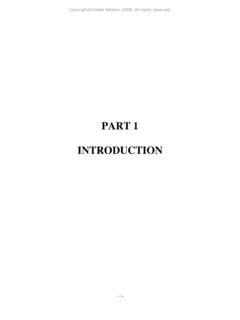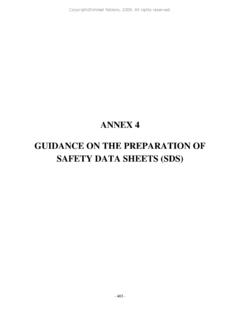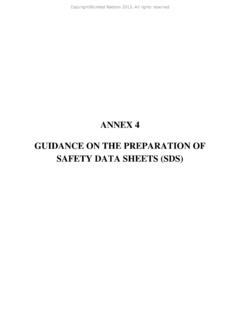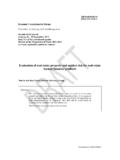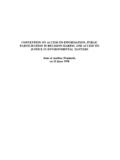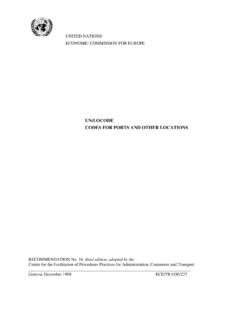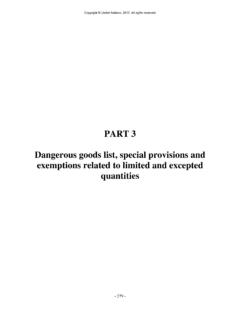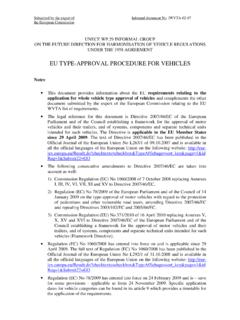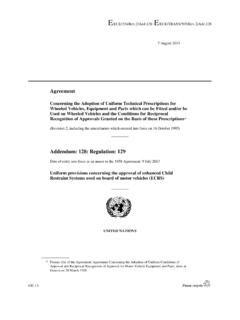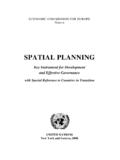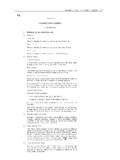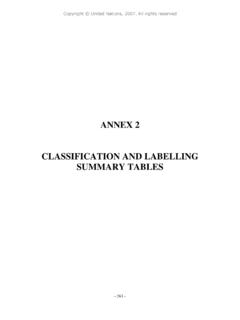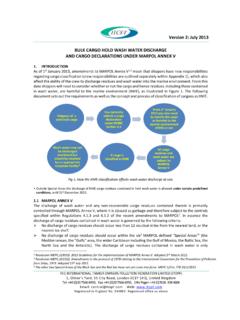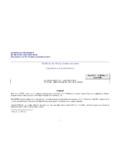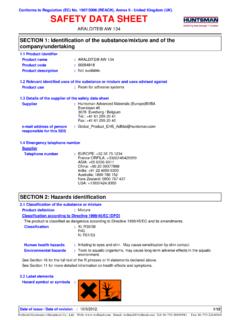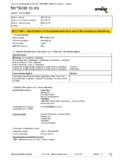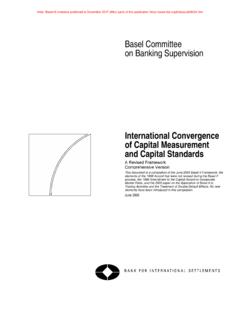Transcription of ANNEX 2 CLASSIFICATION AND LABELLING SUMMARY …
1 - 267 - ANNEX 2 CLASSIFICATION AND LABELLING SUMMARY TABLES Copyright@United Nations, 2009. All rights reserved. Copyright@United Nations, 2009. All rights 269 - ANNEX 2 CLASSIFICATION AND LABELLING SUMMARY TABLES Explosives (see Chapter for details) Hazard category criteria Hazard communication elements Symbol Signal word Danger Unstable explosives According to the results of the test in Part I of the Manual of Tests and criteria , UN Recommendations on the Transport of Dangerous Goods. Hazard statement Unstable explosive Symbol Signal word Danger Division According to the results of the test in Part I of the Manual of Tests and criteria , UN Recommendations on the Transport of Dangerous Goods. Hazard statement Explosive; mass explosion hazard Symbol Signal word Danger Division According to the results of the test in Part I of the Manual of Tests and criteria , UN Recommendations on the Transport of Dangerous Goods.
2 Hazard statement Explosive; severe projection hazard Symbol Signal word Danger Division According to the results of the test in Part I of the Manual of Tests and criteria , UN Recommendations on the Transport of Dangerous Goods. Hazard statement Explosive; fire, blast or projection hazard Symbol Signal word Warning Division According to the results of the test in Part I of the Manual of Tests and criteria , UN Recommendations on the Transport of Dangerous Goods. Hazard statement Fire or projection hazard Symbol Signal word Danger Division According to the results of the test in Part I of the Manual of Tests and criteria , UN Recommendations on the Transport of Dangerous Goods. Hazard statement May mass explode in fire Symbol Signal word No signal word Division According to the results of the test in Part I of the Manual of Tests and criteria , UN Recommendations on the Transport of Dangerous Goods.
3 Hazard statement No hazard statement Copyright@United Nations, 2009. All rights 270 - Flammable gases (see Chapter for details) Hazard category criteria Hazard communication elements Symbol Signal word Danger 1 Gases and gas mixtures, which at 20 C and a standard pressure of kPa: (a) are ignitable when in a mixture of 13% or less by volume in air; or (b) have a flammable range with air of at least 12 percentage points regardless of the lower flammable limit. Hazard statement Extremely flammable gas Symbol No symbol Signal word Warning 2 Gases or gas mixtures, other than those of Category 1, which, at 20 C and a standard pressure of kPa, have a flammable range while mixed in air Hazard statement Flammable gas Flammable aerosols (see Chapter for details) Hazard category criteria Hazard communication elements Symbol Signal word Danger 1 On the basis of its ingredients, of its chemical heat of combustion and, if applicable, of the results of the foam test (for foam aerosols) and of the ignition distance test and enclosed space test (for spray aerosols) (see decision logic under in Chapter )
4 Hazard statement Extremely flammable aerosol Symbol Signal word Warning 2 On the basis of its ingredients, of its chemical heat of combustion and, if applicable, of the results of the foam test (for foam aerosols) and of the ignition distance test and enclosed space test (for spray aerosols) (see decision logic under in Chapter ) Hazard statement Flammable aerosol Copyright@United Nations, 2009. All rights 271 - Oxidizing gases (see Chapter for details) Hazard category criteria Hazard communication elements Symbol Signal word Danger 1 Any gas which may, generally by providing oxygen, cause or contribute to the combustion of other material more than air does Hazard statement May cause or intensify fire; Gases under pressure (see Chapter for details) Hazard category criteria Hazard communication elements Symbol Signal word Warning Compressed gas A gas, which when packaged under pressure is entirely gaseous at -50 C; including all gases with a critical temperature -50 C Hazard statement Contains gas under pressure.
5 May explode if heated Symbol Signal word Warning Liquefied gas A gas which when packaged under pressure, is partially liquid at temperatures above -50 C. A distinction is made between: (a) High pressure liquefied gas: a gas with a critical temperature between 50 C and +65 C; and (b) Low pressure liquefied gas: a gas with a critical temperature above +65 C Hazard statement Contains gas under pressure; may explode if heated Symbol Signal word Warning Refrigerated liquefied gas A gas which when packaged is made partially liquid because of its low temperature Hazard statement Contains refrigerated gas; may cause cryogenic burns or injury Symbol Signal word Warning Dissolved gas A gas which when packaged under pressure is dissolved in a liquid phase solvent Hazard statement Contains gas under pressure; may explode if heated Copyright@United Nations, 2009.
6 All rights 272 - Flammable liquids (see Chapter for details) Hazard category criteria Hazard communication elements Symbol Signal word Danger 1 Flash point < 23 C and initial boiling point 35 C Hazard statement Extremely flammable liquid and vapour Symbol Signal word Danger 2 Flash point < 23 C and initial boiling point >35 C Hazard statement Highly flammable liquid and vapour Symbol Signal word Warning 3 Flash point 23 C and 60 C Hazard statement Flammable liquid and vapour Symbol No symbol Signal word Warning 4 Flash point > 60 C and 93 C Hazard statement Combustible liquid Flammable solids (see Chapter for details) Hazard category criteria Hazard communication elements Symbol Signal word Danger 1 Burning rate test: Substances and mixtures other than metal powders: (a) wetted zone does not stop fire and (b) burning time < 45 s or burning rate > mm/s Metal powders: - burning time 5 min Hazard statement Flammable solid Symbol Signal word Warning 2 Burning rate test: Substances and mixtures other than metal powders: (a) wetted zone stops the fire for at least 4 min and (b) burning time < 45 s or burning rate > mm/s Metal powders: - burning time > 5 min and 10 min Hazard statement Flammable solid Copyright@United Nations, 2009.
7 All rights 273 - Self-reactive substances and mixtures (see Chapter for details) Hazard category criteria Hazard communication elements Symbol Signal word Danger Type A According to the results of tests in the UN Recommendations on the Transport of Dangerous Goods, Manual of Tests and criteria , Part II and the application of the decision logic under in Chapter Hazard statement Heating may cause an explosion Symbol Signal word Danger Type B According to the results of tests in the UN Recommendations on the Transport of Dangerous Goods, Manual of Tests and criteria , Part II and the application of the decision logic under in Chapter Hazard statement Heating may cause a fire or explosion Symbol Signal word Danger Type C and D According to the results of tests in the UN Recommendations on the Transport of Dangerous Goods, Manual of Tests and criteria .
8 Part II and the application of the decision logic under in Chapter Hazard statement Heating may cause a fire Symbol Signal word Warning Type E and F According to the results of tests in the UN Recommendations on the Transport of Dangerous Goods, Manual of Tests and criteria , Part II and the application of the decision logic under in Chapter Hazard statement Heating may cause a fire Signal word Symbol Type G According to the results of tests in the UN Recommendations on the Transport of Dangerous Goods, Manual of Tests and criteria , Part II and the application of the decision logic under in Chapter Hazard statement There are no label elements allocated to this hazard category Copyright@United Nations, 2009. All rights 274 - Pyrophoric liquids (see Chapter for details) Hazard category criteria Hazard communication elements Symbol Signal word Danger 1 The liquid ignites within 5 min when added to an inert carrier and exposed to air, or it ignites or chars a filter paper on contact with air within 5 min Hazard statement Catches fire spontaneously if exposed to air Pyrophoric solids (see Chapter for details) Hazard category criteria Hazard communication elements Symbol Signal word Danger 1 The solid ignites within 5 min of coming into contact with air Hazard statement Catches fire spontaneously if exposed to air Self-heating substances and mixtures (see Chapter for details)
9 Hazard category criteria Hazard communication elementsSymbol Signal word Danger 1 A positive result is obtained in a test using a 25 mm sample cube at 140 C Hazard statement Self-heating; may catch fire Symbol Signal word Warning 2 (a) A positive result is obtained in a test using a 100 mm sample cube at 140 C and a negative result is obtained in a test using a 25 mm cube sample at 140 C and the substance or mixture is to be packed in packages with a volume > 3 m3; or (b) A positive result is obtained in a test using a 100 mm sample cube at 140 C and a negative result is obtained in a test using a 25 mm cube sample at 140 C, a positive result is obtained in a test using a 100 mm cube sample at 120 C and the substance or mixture is to be packed in packages with a volume > 450 litres; or (c) A positive result is obtained in a test using a 100 mm sample cube at 140 C and a negative result is obtained in a test using a 25 mm cube sample at 140 C and a positive result is obtained in a test using a 100 mm cube sample at 100 C Hazard statement Self-heating in large quantities; may catch fire Copyright@United Nations, 2009.
10 All rights 275 - Substances and mixtures, which in contact with water, emit flammable gases (see Chapter for details) Hazard category criteria Hazard communication elements Symbol Signal word Danger 1 Any substance or mixture which reacts vigorously with water at ambient temperatures and demonstrates generally a tendency for the gas produced to ignite spontaneously, or which reacts readily with water at ambient temperatures such that the rate of evolution of flammable gas is 10 litres per kilogram of substance over any one minute Hazard statement In contact with water releases flammable gases which may ignite spontaneously Symbol Signal word Danger 2 Any substance or mixture which reacts readily with water at ambient temperatures such that the maximum rate of evolution of flammable gas is 20 litres per kilogram of substance per hour.
